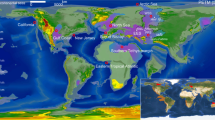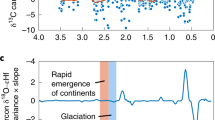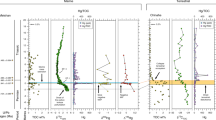Abstract
The Palaeocene–Eocene Thermal Maximum (PETM), an approximately 170,000-year-long period of global warming about 56 million years ago, has been attributed to the release of thousands of petagrams of reduced carbon into the ocean, atmosphere and biosphere1,2. However, the fate of this excess carbon at the end of the event is poorly constrained: drawdown of atmospheric carbon dioxide has been attributed to an increase in the weathering of silicates or to increased rates of organic carbon burial1,3,4,5. Here we develop constraints on the rate of carbon drawdown based on rates of carbon isotope change in well-dated marine and terrestrial sediments spanning the event. We find that the rate of recovery is an order of magnitude more rapid than that expected for carbon drawdown by silicate weathering alone. Unless existing estimates of carbon stocks and cycling during this time are widely inaccurate, our results imply that more than 2,000 Pg of carbon were sequestered as organic carbon over 30,000–40,000 years at the end of the PETM. We suggest that the accelerated sequestration of organic carbon could reflect the regrowth of carbon stocks in the biosphere or shallow lithosphere that were released at the onset of the event.
This is a preview of subscription content, access via your institution
Access options
Subscribe to this journal
Receive 12 print issues and online access
$259.00 per year
only $21.58 per issue
Buy this article
- Purchase on Springer Link
- Instant access to full article PDF
Prices may be subject to local taxes which are calculated during checkout



Similar content being viewed by others
References
Zeebe, R. E., Zachos, J. C. & Dickens, G. R. Carbon dioxide forcing alone insufficient to explain Palaeocene–Eocene Thermal Maximum warming. Nature Geosci. 2, 576–580 (2009).
K., Panchuk, Ridgwell, A. & Kump, L. R. Sedimentary response to Paleocene–Eocene thermal maximum carbon release: A model-data comparison. Geology 36, 315–318 (2008).
Bains, S., Norris, R. D., Corfield, R. M. & Faul, K. L. Termination of global warmth at the Palaeocene/Eocene boundary through productivity feedback. Nature 407, 171–174 (2000).
Dickens, G. R. in Western North Atlantic Palaeogene And Cretaceous Palaeoceanography Vol.9 (eds Kroon, K., Norris, R. D. & Klaus, A.) 293–305 (Geological Society Publishing House, 2001).
Dickens, G. R., Castillo, M. M. & Walker, J. C. G. A blast of gas in the latest Paleocene; simulating first-order effects of massive dissociation of oceanic methane hydrate. Geology 25, 259–262 (1997).
Sluijs, A., Bowen, G. J., Brinkhuis, H., Lourens, L. J. & Thomas, E. in Deep Time Perspectives on Climate Change: Marrying the Signal from Computer Models and Biological Proxies (eds Williams, M., Haywood, A., Gregory, J. & Schmidt, D. N.) 267–293 (Geological Society of London, TMS Special Publication, 2007).
Bowen, G. J., Beerling, D. J., Koch, P. L., Zachos, J. C. & Quattlebaum, T. A humid climate state during the Palaeocene–Eocene thermal maximum. Nature 432, 495–499 (2004).
McCarren, H., Thomas, E., Hasegawa, T., Rohl, U. & Zachos, J. C. Depth dependency of the Paleocene–Eocene carbon isotope excursion: Paired benthic and terrestrial biomarker records (Ocean Drilling Program Leg 208, Walvis Ridge). Geochem. Geophys. Geosyst. 9, Q10008 (2008).
Farley, K. A. & Eltgroth, S. F. An alternative age model for the Paleocene–Eocene thermal maximum using extraterrestrial He-3. Earth Planet. Sci. Lett. 208, 135–148 (2003).
Kelly, D. C., Nielsen, T. M. J., McCarren, H. K., Zachos, J. C. & Röhl, U. Spatiotemporal patterns of carbonate sedimentation in the South Atlantic: Implications for carbon cycling during the Paleocene–Eocene thermal maximum. Palaeogeogr. Palaeoclimatol. Palaeoecol. 293, 30–40 (2010).
Bains, S., Corfield, R. M. & Norris, R. D. Mechanisms of climate warming at the end of the Paleocene. Science 285, 724–727 (1999).
Aziz, H. A. et al. Astronomical climate control on paleosol stacking patterns in the upper Paleocene-lower Eocene Willwood Formation, Bighorn Basin, Wyoming. Geology 36, 531–534 (2008).
Bowen, G. J. et al. in Paleocene–Eocene Stratigraphy and Biotic Change in the Bighorn and Clarks Fork Basins, Wyoming (ed. Gingerich, P. D.) 73–88 (Univ. Michigan Museum of Paleontology, 2001).
Sundquist, E. T. in The Carbon Cycle and Atmospheric CO2: Natural Variations Archean to Present, Geophysical Monograph Vol.32 (eds Sundquist, E. T. & Broecker, W. S.) 5–59 (American Geophysical Union, 1985).
Kelly, D. C., Zachos, J. C., Bralower, T. J. & Schellenberg, S. A. Enhanced terrestrial weathering/runoff and surface ocean carbonate production during the recovery stages of the Paleocene–Eocene thermal maximum. Paleoceanography 20, PA4023 (2005).
Falkowski, P. et al. The global carbon cycle: A test of our knowledge of Earth as a system. Science 290, 291–296 (2000).
Hedges, J. I. & Keil, R. G. Sedimentary organic matter preservation: An assessment and speculative synthesis. Mar. Chem. 49, 81–115 (1995).
Demicco, R. V., Lowenstein, T. K. & Hardie, L. A. Atmospheric pCO2 since 60 Ma from records of seawater pH, calcium, and primary carbonate mineralogy. Geology 31, 793–796 (2003).
Pearson, P. N. & Palmer, M. R. Atmospheric carbon dioxide concentrations over the past 60 million years. Nature 406, 695–699 (2000).
Zeebe, R. E. & Zachos, J. C. Reversed deep-sea carbonate ion basin gradient during Paleocene–Eocene thermal maximum. Paleoceanography 22, PA3201 (2007).
Delaney, M. L. & Boyle, E. A. Tertiary Paleoceanic chemical variability: Unintended consequences of simple geochemical models. Paleoceanography 3, 137–156 (1988).
Gibbs, M. T., Bluth, G. J. S., Fawcett, P. J. & Kump, L. R. Global chemical erosion over the last 250 my: Variations due to changes in paleogeography, paleoclimate, and paleogeology. Am. J. Sci. 299, 611–651 (1999).
John, C. M. et al. North American continental margin records of the Paleocene–Eocene thermal maximum: Implications for global carbon and hydrological cycling. Paleoceanography 23, PA2217 (2008).
Sluijs, A. et al. Subtropical Arctic Ocean temperatures during the Palaeocene/Eocene thermal maximum. Nature 441, 610–613 (2006).
Bolle, M. P. et al. The Paleocene–Eocene transition in the marginal northeastern Tethys (Kazakhstan and Uzbekistan). Int. J. Earth Sci. 89, 390–414 (2000).
Beerling, D. J. Increased terrestrial carbon storage across the Palaeocene–Eocene boundary. Palaeogeogr. Palaeoclimatol. Palaeoecol. 161, 395–405 (2000).
Buffett, B. & Archer, D. Global inventory of methane clathrate: Sensitivity to changes in the deep ocean. Earth Planet. Sci. Lett. 227, 185–199 (2004).
Huber, M. A hotter greenhouse? Science 321, 353–354 (2008).
Wing, S. L., Harrington, G. J., Bowen, G. J. & Koch, P. L. in Causes and Consequences of Globally Warm Climates in the Early Paleogene Vol.369 (eds Wing, S. L., Gingerich, P. D., S., Birger & Thomas, E.) 425–440 (Geological Society of America Special Paper, 2003).
Harrington, G. J. & Jaramillo, C. A. Paratropical floral extinction in the Late Paleocene-Early Eocene. J. Geol. Soc. Lond. 164, 323–332 (2007).
Acknowledgements
This work was supported by US National Science Foundation grants EAR-0628302 and OCE-0902882 to G.J.B. and EAR-0628719 to J.C.Z. We thank L. Kump, R. Zeebe and J. Dickens for comments that improved earlier versions of the manuscript. This is Purdue Climate Change Research Center paper 1040.
Author information
Authors and Affiliations
Contributions
G.J.B. conceived and carried out the study. J.C.Z. advised on age models for marine records. Both authors wrote the manuscript.
Corresponding author
Ethics declarations
Competing interests
The authors declare no competing financial interests.
Supplementary information
Supplementary Information
Supplementary Information (PDF 454 kb)
Rights and permissions
About this article
Cite this article
Bowen, G., Zachos, J. Rapid carbon sequestration at the termination of the Palaeocene–Eocene Thermal Maximum. Nature Geosci 3, 866–869 (2010). https://doi.org/10.1038/ngeo1014
Received:
Accepted:
Published:
Issue Date:
DOI: https://doi.org/10.1038/ngeo1014
This article is cited by
-
The Eurasian epicontinental sea was an important carbon sink during the Palaeocene-Eocene thermal maximum
Communications Earth & Environment (2022)
-
Upper limits on the extent of seafloor anoxia during the PETM from uranium isotopes
Nature Communications (2021)
-
Chance played a role in determining whether Earth stayed habitable
Communications Earth & Environment (2020)
-
Earth system feedback statistically extracted from the Indian Ocean deep-sea sediments recording Eocene hyperthermals
Scientific Reports (2017)
-
Very large release of mostly volcanic carbon during the Palaeocene–Eocene Thermal Maximum
Nature (2017)



